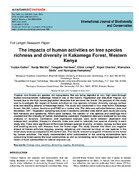| dc.contributor.author | Vuyiya, Esther | |
| dc.contributor.author | Konje, Martha | |
| dc.contributor.author | Tsingalia, Harrison | |
| dc.contributor.author | Obiet, Leonard | |
| dc.contributor.author | Kigen, Charles | |
| dc.contributor.author | Wamalwa, Stella | |
| dc.contributor.author | Nyongesa, Humphrey | |
| dc.date.accessioned | 2019-05-06T10:49:31Z | |
| dc.date.available | 2019-05-06T10:49:31Z | |
| dc.date.issued | 2014-06-01 | |
| dc.identifier.issn | 2141243X | |
| dc.identifier.uri | 10.5897/IJBC2014.0711 | |
| dc.identifier.uri | https://academicjournals.org/article/article1402653748_Esther%20et%20al.pdf | |
| dc.identifier.uri | http://erepository.kibu.ac.ke/handle/123456789/847 | |
| dc.description.abstract | Tropical rain forests are species rich ecosystems that are being depleted at very high rates through human encroachment. Kakamega forest is one of the heavily fragmented and disturbed tropical rain forests due to the high human population densities that surround the forest. The purpose of this study was to investigate the impact of human activities on tree species richness, diversity, canopy surface area and seedling density in Kakamega forest. The study was conducted in four sites within Kakamega forest: Handidi, Lukusi, Isecheno and KWS as a control site. The data was collected between June and December, 2011. Vegetation sampling was done in randomly selected sites within each study site using belt transects and quadrants. Within each transect, the number of tree species and seedlings were counted and the intensity of human disturbances assessed. Vegetation data were analyzed by two-way analysis of variance. Correlation and regression analysis were done between dependent and independent variables. Simpson’s diversity index was used to calculate tree species diversity in each study site. There were significant differences between species diversity, richness, canopy surface area and seedling density with distance from the forest edge. The study showed that there was negative impact of human activities (logging, grazing, debarking and charcoal burning) on tree species in the three study sites as compared to the control site. The results revealed a negative influence on the forest by human activities. The study recommended strict enforcement of the existing conservation laws concerning forest use by the local communities as well as formulating more integrated approach to the needs of local communities for natural resource use. | en_US |
| dc.language.iso | en | en_US |
| dc.publisher | Academic Journals : International Journal of Biodiversity and Conservation | en_US |
| dc.rights | Attribution-NonCommercial-ShareAlike 3.0 United States | * |
| dc.rights.uri | http://creativecommons.org/licenses/by-nc-sa/3.0/us/ | * |
| dc.subject | Canopy area | en_US |
| dc.subject | seedlings | en_US |
| dc.subject | debarking | en_US |
| dc.subject | logging. | en_US |
| dc.subject | disturbances | en_US |
| dc.title | The impacts of human activities on tree species richness and diversity in Kakamega Forest, Western Kenya | en_US |
| dc.type | Article | en_US |

